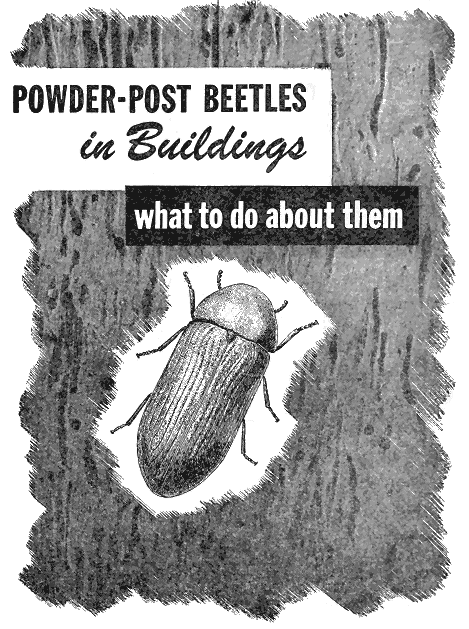

Leaflet No. 358
U.S. DEPARTMENT OF AGRICULTURE
Powder-Post Beetles in Buildings
WHAT TO DO ABOUT THEM
Powder-post beetles cause extensivedamage to wood in the structure ofbuildings and to wood products used inhomes.
The larvae, or grubs, feed on thestarch or the cellulose in wood. Asthey feed, they bore irregular tunnelsthrough the wood. Borings left in thetunnels have the consistency of powder.
Powder-post beetles can be controlledby applying an insecticide to the infestedwood. How it is applied dependson the kind of beetle to be controlledand on the extent and locationof the infestation. In some circumstancesa spray will suffice; in others,fumigation is necessary.
COMMON AND SCIENTIFIC NAMES
OF INSECTS DISCUSSED
| Southern lyctus beetle | Lyctus planicollis |
| Common furniture beetle | Anobium punctatum |
| Death-watch beetle | Xestobium rufovillosum |
| Old house borer | Hylotrupes bajulus |
| Red-shouldered shothole borer | Xylobiops basilaris |
| Black-horned pine borer | Callidium antennatum |
| Bamboo powder-post beetle | Dinoderus minutus |
| Bamboo borer | Chlorophorus annularis |
KINDS
Powder-post beetles are divided intofive groups—lyctus beetles, anobiidbeetles, bostrichid beetles, cerambycidbeetles, and cossonid weevils.
Lyctus beetles are reddish to blackish,about ¼ inch long, and slightlyflattened. One common species isknown as the southern lyctus beetle.
Anobiid beetles are similar to lyctusbeetles in color and size, but arecylindrical. The common furniturebeetle and the death-watch beetle belongin this group.
Bostrichid beetles are reddish,brown, or black; they are ⅛ to ¾inch long, and cylindrical.
The heads of anobiids and bostrichidsare directed downward and arecovered by a "hood."
The cerambycids, also known asroundheaded or long-horned beetles,are blue, black, or pale yellow to reddishbrown, and often bear distinctivemarkings on the head or the wing covers.They are ½ to 1 inch long,and vary in shape. The old houseborer belongs in this group. It isblack, and has grayish markings onthe wing covers. It is about ¾ inchlong.
Cossonid weevils are reddish brownor black, ⅛ to ⅕ inch long, andoval to cylindrical. Their heads aredrawn out to form a short, broad beak.Cossonids are the only weevils that infestwood; other weevils infest grainor growing crops.
LIFE CYCLE
The adult females